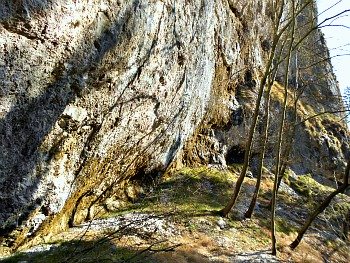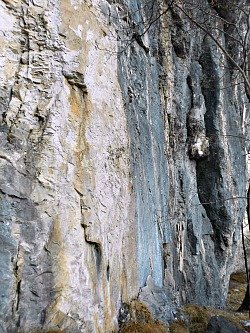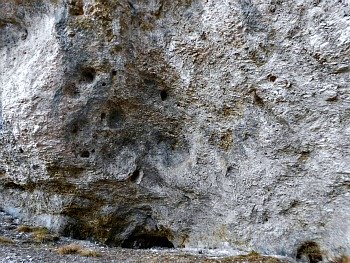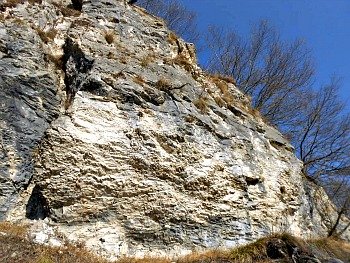- Italy Tours Home
- Italy Ethos
- Tours 2023
- Blog
- Contact Us
- Dolomites
- Top 10 Dolomites
- Veneto
- Dolomites Geology
- Dolomiti Bellunesi
- Cortina
- Cadore
- Belluno
- Cansiglio
- Carso
- Carnia
- Sauris
- Friuli
- Trentino
- Ethnographic Museums
- Monte Baldo
- South Tyrol
- Alta Pusteria
- Dobbiaco
- Emilia-Romagna
- Aosta Valley
- Cinque Terre
- Portofino
- Northern Apennines
- Southern Apennines
- Italian Botanical Gardens
- Padua Botanical Garden
- Orchids of Italy
Valle di Lamen: One of the Most Notable Locations Within the Dolomiti Bellunesi National Park.

The “Covoli di Lamen”
The Valle di Lamen (Lamen valley) is a side valley situated at the margins of the Vette Feltrine, in the Dolomiti Bellunesi National Park. It is a particularly noteworthy location for the so-called “Covoli di Lamen”, which is a site of archaeological relevance, but the area is interesting also for its naturalistic value. It can be accessed from Pedavena – a town just north of Feltre, where one of the Park’s Visitor Centres (the “Sasso nello Stagno” – “Stone in the Pond”) is also located.
A thematic Archaeological trail has been devised here by the Park; for a more detailed description of this, refer to Vette Feltrine. The purpose of this page is instead that of focusing on the archaeological and historical evidence connected to this site, with occasional comments on other related topics too (such as the natural environment and the mythological layer).
An exam of the bones collected up to now in the Neolithic layers of the “Riparo Tomas” and the “Covoli Alti” (a word that basically means 'shelter'; see image above) has allowed to identify domestic animals such as cattle, goat and pig. In the archaeological layers from the Bronze Age one can notice a prevalence of sheep and goat, but also remnants of an oxen of small dimensions and of mature pigs. In the sites that have been studied the traces of wild fauna are quite limited; only parts of a roe deer and of a deer have been recuperated.
Archaeological evidence has allowed to identify evidence of animal farming in the ‘Covoli’ distributed along the trail: mostly of sheep and goat, but also oxen and pig – all along the recent Neolithic until the whole Bronze Age, and again from the Late Ancient period to the Middle Ages. On the other hand, even if hunting was practiced, this activity has only left sparse archaeological traces. Hunting was particularly important at the onset of the Neolithic culture, in the period known as of the “Vasi a Bocca Quadrata” (‘Square Mouth Vases’), but with the development of this culture, agriculture and farming became almost the only source of supply of food.
As for the use of the ‘Covoli’, one can advance three hypotheses: the first is their consistent usage throughout the year as permanent dwellings; the second is use for the months of spring and autumn only, as an intermediate stop-over in the movement towards the pastures at higher altitudes (‘alpeggi’) during the summer; the third hypothesis is their use as temporary dwellings, in alternation with lower valley agriculture – as witnessed by the sites at Pedavena and Vignui, close to the Valle di Lamen, but also in other locations which are further distances away like Triches and Trichiana, on the left side of the Val Belluna.
The last theory seems the most credible one, and the agro-pastoral management of these sites would not have been much different from that operated by the ‘malghe’ (dairy pens) located at middle altitudes (known as ‘majolere’) until some decades ago, when the animals were taken to mountain pastures in spring and the family divided within the circle of its members the tasks of looking after the livestock, cheese-making and tending the fields on the lower valley floors. Permanence at the ‘Covoli Alti’ was favoured, for a good part of the year, by the Atlantic climate– that is by temperate and humid conditions, which allowed a long season on the pastures for the animals.
In the Middle and recent Bronze Age the occupation of the ‘Covoli’ was – in all likelihood – linked not only to animal farming but also to a basic summer agriculture, as documented by the presence of remnants of broad beans found within the deposits of the shelters. In the Late Bronze Age one can think of the fact that human presence in the Valle di Lamen was probably connected to a road that – through the Croce d’Aune pass – led on to Trentino, where the mining districts to the north (in the region of Primiero) probably already attracted workforce for the excavation and supply of raw materials.
As for the historic period, one is inclined to believe in the practice of ever more specialized animal farming techniques; these were carried out by nomad shepherds – perhaps only passing through in the intermediate seasons towards the high altitudes, through an analogous trail to the one which is currently being used to reach the Vette Feltrine (CAI-marked trail 815 A). This affirmation is mostly based on the presence of remains of meals or food, collected in the sites linked to the archaeological layers corresponding to this age, which reveal almost exclusively the presence of sheep and goat.
The “Tomass B” Shelter
In 1998 – in parallel with the research carried out in the main shelter – it was proceeded to open a excavation dig of 12 m in the small adjoining shelter, known as “Tomass B”. Already in the first phase of recovery a group of nine coins in a pile was found, which we can speculate were part of a small treasure or a deposit of coins, which could then be referred to the first few years of the 13th century. Subsequently, a ditch was excavated that revealed in all likelihood a burial ground: the hole presented a sub-rectangular shape and a depth of about 70 cm, hosting a buried body orientated W->E, in an optimal state of conservation. Above the head and the chest there was a big rough stone with the function of cover; the head was laid on a rough pillow made of flat stones disposed as in a crown. Not an object was found to be referred to grave goods; it is however possible – from stratigraphic analysis – to locate the burial in a contemporary age, or before the Middle age layers – with sand certainly preceding, in any case, the deposit of coins.
The coins found in the “Tomass B” sector had been minted by the Republic of Venice; six of them can be ascribed to the Doge Orso Malipiero and three to the Doge Enrico Dandolo. These were ‘denari’ connected with the reformation of Charlemagne, who established the basis of the European monetary system, then remained in place all the way to Napoleon. This system was based on three units: ‘lira’, ‘soldo’ and ‘denaro’ – the latter equaling to about 1/240 of a lira. It is also possible to connect the coins to a passage of soldiers or of people fleeing that were looking for an escape towards the north, through the Valle di Lamen and then on to the Croce d’Aune pass.
The Legend of the ‘Mazarol’
In the old times there lived here – in the thickest and least accessible of woods – a small man, like an elf, known as ‘Mazarol’; he had a long beard and straggly hair, and a coarse and mischievous face. He was all dressed in red, complete with a hood and pointed shoes, and used to live in the wide ‘Covoli’ – but he was so shy as to avoid almost any contact with human beings. However, legend has it that the ‘Mazarol’ had extraordinary knowledge as a shepherd and ‘malgaro’ (cheese maker): he took good care of his animals – namely cattle, goat and sheep: he nourished them properly and took them to the grazing fields, making them grow very fast and in an exemplary way.
According to this ancient count – transmitted orally, with a few variants, in the whole of the val Belluna – the mountain people have learned the art of cheese making by spying on the ‘Mazarol’, when in his ‘Covolo’ he would be producing butter, cheese and ricotta. While creating this trail – that connects in a single itinerary nature and human presence – the desire was that of recalling this atmospheric count: it is intriguing to think that a trace of the presence of the ancient dwellers of these natural shelters has remained in the collective memory, as carried over also by the legend of the ‘Mazarol’.

Geology of the Valle di Lamen
The Valle di Lamen is situated on the threshold between two important tectonic structures; this geologic situation has concurred to the formation of the shelters under the rocks. The most ancient rocks that surface in the Vette Feltrine chain, which can be encountered along most of the trail, belong to the Triassic formation of Main Dolomite (see image above), which presents itself in the form of stratified (‘layered’) or massive banks, of white or whitish-grey colour when freshly fractured, while they tend to be grey or black after the alterations caused by the atmospheric agents. Above these lay Grey Limestone – carbonate deposits from the Jurassic period.
About 60-40.000 years ago, very restricted groups of Munsterian hunters (belonging to the Middle Paleolithic) established themselves in the area, as it is being witnessed by some artifacts in flint found on the summit of Monte Avena (at about 1,500 m of altitude). At Campon – in a depression that opens up along the southern slope of the plateau near the top of Monte Avena, at an altitude of 1,450 m – a site was dug that has given a few thousand objects obtained by chipping away at the flint stones that were surfacing on that same location; amongst these were pre-nuclei, residues of the chipping process and other instruments.
The latter are in modest numbers, and that seems to suggest that they were being used elsewhere – probably in the valley floors or in the pre-Alpine hilly belt. This typology of instruments (careened gravers known as burins; careened scratchers) was obtained with lamellar retouching; very fine retouched gills (or lamellae) and nuclei (lamellar rabots with separations) – characteristic of the Aurignacian culture (Upper Paleolithic) – were also dug up. This period is linked to the diffusion of Homo sapiens (Cro-Magnon), as it appeared in Europe at the end of the interglacial stage of Arcy 38-30.000 years ago (hence the name); in this time lapse is to be positioned also the frequentation of Monte Avena on the part of the Aurignacian populations.
A new revolution in the daily life of man happened with the advent of the Copper Age and the successive Bronze Age, around 5000 years ago: at that point, not only metals were introduced – together with the technologies that came with them – but a more complex and systematic use of domestic mammals began too: these, which originally were intended only for the production of meat, also started to be exploited as a source of secondary products, such as milk and wool, and also for energy production (transportation, plowing, etc). Only in the subsequent Iron Age (with the Paleo-veneti, Etruscans and Romans) developed the economies – based on commerce and the maximum exploitation of resources – that led to the selection of different species of domestic animals, and further diversification in their use. These changes were confirmed by the bone deposits that were found in various archaeological digs, recognizable – both in Veneto and in Emilia – by observing the development in the dimension of the animals and the percentage of changes in the age (and sometimes also in the sex) of the raised species.
The north of the Italian peninsula, around 6000 years ago, was the theatre of a huge cultural unification, which spread from Liguria to Veneto, at the hands of the people belonging to the so-called “Civiltà dei Vasi a Bocca Quadrata” (‘Square Mouth Vases Civilization’), already mentioned above. This culture – exclusive to Northern Italy – was presenting right from the start strong spiritual affinities with the Balcanic world, noticeable most of all in the presence of small female figures and the objects known as ‘pintadere’.
The following period corresponded, from a climatic point of view, to the second pre-glacial Wurmian, during which the mountains and the valley mouths were covered by extensive glaciers. With the start of the de-glaciations, the Pre-Alpine areas began to be populated again; this process later spread to the Alps too between 14.000 and 13.000 years ago. During the glacial expansion known as Dryas I, groups of hunters from the Epigravettian settled at the foothills of the Pre-Alps of Veneto hunting the mythical hur, elk and ibex.
The following culture – called Neolithic – is much better known, and also well-represented in the area of the park; it indicates the cultural stage in which productive economies became established thanks to the introduction of agriculture and animal farming; tools in polished stone and ceramic objects also began to appear. The Neolithic started – according to the most recent data research – in the Near East, then spread slowly along the Mediterranean coasts; allegedly, it arrived in the Po Valley and the Central-Eastern Alpine region around 6,500 years ago, provoking the passage from a hunter-gatherer form of social organization to an agricultural one, also with an embryonic form of sheep farming.
The Climate During the Holocene
At the end of the last glaciations, the area of the Vette Feltrine – including the Valle di Lamen – must have appeared completely devoid of vegetation. From around 11,300 to 6,800 years ago, colder spells alternated with more temperate periods; in sequence: milder Allerod, colder Dryas II, temperate Bolling, colder Dryas III. On the whole, however, the climate became much more favourable to habitation; lush woodland started to develop, while in altitude the montane pastures and meadows expanded. With the subsequent periods – in particular the warm and arid Pre-boreal and the temperate and arid Boreal – the Holocene started.
From 6,800 to 4,600 years ago – with the period known as Atlantic – the climate became warm and humid, and as a matter of fact an optimum was reached in the whole of the Alpine region: the forests elevated to altitudes about 200 metres higher than the actual tree line, while the montane habitat displayed its maximum splendor; vast broadleaved forests – in the valley floors mainly composed of beech – were generated, which touched 1,700 metres, while conifer forests dominated at the superior levels.
Many soil types – sterile beforehand – became fertile, with good supplies of organic substance; in fact, at the highest altitudes, that fertility still continues. But from about 4,600 years ago the climate became mild and dry; as a consequence, the upper level reached by the vegetation (tree line) became considerably lower, touching altitudes even inferior to those of the Mesolithic age. Beech was no longer present at altitudes above 1,000 metres, while the high-altitude forests left their place to meadows, which could become established owing to the fertility of the soils formerly occupied by forests. These environmental conditions remained fundamentally unchanged – in the so-called “montane belt” – during the Copper, Bronze and Iron Age.

The “Ripari Alti” (‘High Shelters’)
These high shelters (see image above) were being used by man on several occasions and for different purposes. In more recent times, timber would be kept there, stacked with care after being cut, as part of the yearly rhythm of looking after the woodland. Fragments of grenades witness instead the use of these shelters during the two world wars – maybe as places where to take refuge (as they were hidden away from view), or particularly apt for storing material, as they remained dry. For these same reasons, perhaps, they were already being used as far back as during the barbaric invasions – but in that respect there are no certainties from an archeological point of view.
On the contrary, on the floor of the so called “Riparo del teschio” (‘the skull shelter’), a ring or seal in bronze from the Late Roman period was found, which indicates frequentation of this site at a much earlier time. In the deep layers of sediments that were accumulated inside these caverns was ascertained the presence of man even as far back as the Neolithic: various utensils in flint, bone and horn came to light here, witnessing the daily activities of a small community. The total absence of wild animals’ bones, in the food remains excavated, seems to hint at the presence of peaceful groups dedicated to the raising of domestic animals.
Permanence at the “Covoli Alti” for a good part of the year was possible – during the Neolithic period – thanks to the Atlantic climate, which was optimal for the Alpine area, as it was temperate and humid. Humidity was a very important factor especially for raising animals, as livestock needs a great quantity of water and normally this tends not to be readily available on the slopes and in the meadows situated on karstic terrain, where water is not retained and escapes quite quickly – as here. The “Covoli Alti” could be accessed with the livestock from the slopes of Monte Pafagai (1,047 m) by following the ridge between the Valle di Lamen and the adjacent Valle di San Martino (see Vette Feltrine; below is an image of the rocks emerging along the trail), then continuing on along Dosso Perazze – in a reversed fashion when compared to the suggested direction for the thematic trail as it has been devised by the Park today.

The Valle di San Martino
“Is it tougher uphill or downhill?”. The answer is so simple that even the eagles figured it out. They always carry prey downhill, gliding to the nest they built in the areas below the prairies, where they hunt. It happens right here, in the Valle di San Martino, too.
Adjacent to the Valle di Lamen, the Valle di San Martino, which develops on the southern slopes of the Vette Feltrine, drawing in depth on its tough, tenacious calcareous-Dolomitic rock banks. The Stien stream and its small tributaries are fed by karstic springs which drain part of the water that infiltrate under the Vette Plateau. Among the most characteristic forms in the landscape are the glacial valleys that come down from the Vette (such as at Scalòn); the cyclopic boulders deposited at the end of the glaciations (at Pian dei Violini) and the beautiful series of pot-holes, which can be seen in the upper stretch of the little Stien stream.
The vegetal landscape is mostly characterized by woodland and wooded cliffs, with the prevalence of montane and sub-montane beech wood, also with Hop Hornbeam (Ostrya carpinifolia). In the rocky environments Hanging Cinquefoil (Potentilla caulescens) prevales, often accompanied by Mountain Spirea (Spiraea hacquetii) – an endemic species to Veneto and Friuli – and also by the beautiful Alpine Devil’s Claw (Physoplexis comosa); sometimes the showy Tyrolean Primrose (Primula tyrolensis) can also be spotted – another notable endemic plant of the Dolomites.
In the fresh and narrow ravines of the Stien stream one can also observe other typical species, such as Alpine Buttercup (Ranunculus alpinus) and the Minute Alpine Bluebell (Soldanella alpina). The valley – secluded and tranquil despite the closeness to Feltre and its outlying hamlets – hosts also a rich Alpine wildlife, observable even at lower altitudes. Amongst the most easily spotted animals are Chamois (Rupicapra spp.), Roe Deer (Capreolus capreolus), Black Woodpecker (Dryocopus martius) and Hazel Grouse (Tetrastes bonasia); more occasionally, Golden Eagle (Aquila chrysaetos) can be seen too.
Return from Valle di Lamen to Vette Feltrine
Return from Valle di Lamen to Italy-Tours-in-Nature
Copyright © 2013 Italy-Tours-in-Nature

New! Comments
Have your say about what you just read! Leave me a comment in the box below.